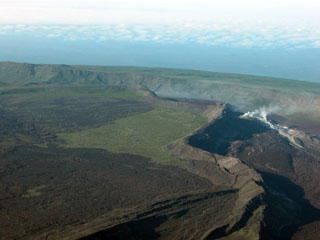Report on Sierra Negra (Ecuador) — 20 June-26 June 2018
Smithsonian Institution / US Geological Survey
Weekly Volcanic Activity Report, 20 June-26 June 2018
Managing Editor: Sally Sennert.
Please cite this report as:
Global Volcanism Program, 2018. Report on Sierra Negra (Ecuador) (Sennert, S, ed.). Weekly Volcanic Activity Report, 20 June-26 June 2018. Smithsonian Institution and US Geological Survey.
Sierra Negra
Ecuador
0.83°S, 91.17°W; summit elev. 1124 m
All times are local (unless otherwise noted)
On 22 June IG reported increased seismic activity at Sierra Negra on the S end of Isabela Island; the largest event, a M 4.2, was recorded at 0624 and felt in El Cura and San Joaquín, NE of the volcano. A M 5.3 earthquake was detected at 0315 on 26 June, occurring at a depth of 5.3 km below Sierra Negra. The event was strongly felt on the upper flanks and in Puerto Villamil (23 km SE). Several aftershocks and subsequent tremor were recorded. An earthquake swarm began at 1117, characterized by events located 3-5 km depth. A M 4.2 earthquake was recorded at 1338, and followed by increasing amplitudes of seismic and infrasound signals. Parque Nacional Galápagos staff heard noises described as bellows coming from Volcán Chico fissure vent, and coupled with the seismicity and infrasound data, suggested the start of an eruption. An IG report posted 20 minutes later described a thermal anomaly identified in satellite images in the N area of the caldera, near Volcán Chico. Park staff observed lava flowing towards the crater’s interior as well as towards the N flank.
Geological Summary. The broad shield volcano of Sierra Negra at the southern end of Isabela Island contains a shallow 7 x 10.5 km caldera that is the largest in the Galápagos Islands. Flank vents abound, including cinder cones and spatter cones concentrated along an ENE-trending rift system and tuff cones along the coast and forming offshore islands. Although it is the largest of the five major Isabela volcanoes, it has the flattest slopes, averaging less than 5° and diminishing to 2° near the coast. A sinuous 14-km-long, N-S-trending ridge occupies the west part of the caldera floor, which lies only about 100 m below its rim. The Volcán de Azufre fumarolic area lies within a graben between this ridge and the west caldera wall. Lava flows from a major eruption in 1979 extend all the way to the north coast from circumferential fissure vents on the upper northern flank.
Source: Instituto Geofísico-Escuela Politécnica Nacional (IG-EPN)

